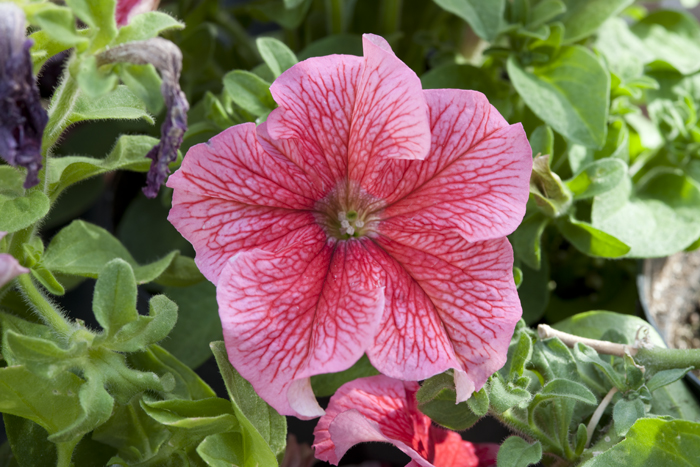Enigma is a petunia that was genetically engineered by the artist Eduardo Kac. Enigma is a normal petunia except its genome contains one of Kac's genes, specifically the gene called IGK. This gene encodes for part of the imunoglobulin protein which functions in our immune system. Kac engineered engima so that it expresses his IGK gene, but only in the flower's veins. He did this by first cloning the IGK gene behind a promoter from a plant virus which is usually only turned on in plant veins. This is a rather simple but cool project that can be carried out in most plant molecular biology labs.
 |
| Eduardo Kac, Natural History of the Enigma, transgenic flower with artist's own DNA expressed in the red veins, 2003/2008. Collection Weisman Art Museum. Photo: Rik Sferra. |
In the picture or enigma the red color signifies where his IGK gene is being expressed. While this is visually pleasing, its also a bit misleading, leading the unwary reader to think this "red" is due to blood. While Kac isolated his IGK gene from his own blood, imunoglobulins are colorless. The reason enigma's veins is not due to Kac's gene, but rather due to a plant gene which controls the expression of genes necessary for making anthocyanins, the plant's red pigments.
Kac calls enigma a "plantimal, a new life form [he] created that ... is a hybrid of myself and Petunia".
This is also could be misleading. Enigma is not a "hybrid", which implies a true mixing of parts [see comments below]. Enigma is at best 0.003% Kac, 99.997% petunia. Considering that plants contain many genes normally thought of as human, such as BrcA and Cftr (encoding the genes for breast cancer and cystic fibrosis), perhaps all plants are actually "plantimals". Or maybe considering that humans normally contain many genes originally thought of as plant, such as Det1 and Cop9 (genes necessary for photomorphogenesis, plant development in the light), maybe we ought to be considered "aniplants"?
In any event, I think Kac is to be applauded for pushing the boundaries of art and science, and for carrying out research project which well exemplifies how genetic engineering works! If you're interested, you can by your own enigma seeds on Kac's website.
Your idea to consider humans anIplants will get my vote every time. Thanks for sharing this one - it is a wonderful project.
ReplyDeleteI have to say considering "enigma" is like learning a new language for me. For example, i didn't realize that "hybrid" has a different meaning in the art world then it does in agriculture! Eduardo pointed this out to me. As i said, cool and I love the possibilities.
DeleteHey Danny - thanks for taking this up! I'm curious why you consider this in the genre/genus performance art, rather than sculpture. Is there something about 'expression in time' that points in that direction, or were you using a catchy denominator in a way similar to 'hybrid'... What interests me is how the work questions how objects are constituted, in particular living ones, what agency or authorship an artist (or scientist) may claim, and how complex 'matter' really is.
ReplyDeleteThank you for clarifying several of the assertions in the work. On the other side, misleading-ness, with a point, is often a tool of the arts (cf Picasso's "art is a lie that tells a greater truth"). So here we might have a good example of the parallel - or tangled - claims of art and science. thanks again for the provocative review!
I call it perfomance art (of course with no art training myself!) because the "art" is not only the flower, but the process, so that the artist is part of the project.
DeleteI agree regarding "misleadingness". I'm reevaluating my take on this!
Thanks for the comment!
Danny -
ReplyDeleteI was walking through a redwood forest with a friend recently and he asked: these trees are so big, but it doesn't seem like the soil is disappearing; how much of a tree is air?
The soil shouldn't disappear - A tree doesn't eat soil. It simply absorbs water and minerals from the soil. Trees eat light and CO2, turning them into sugar (which becomes biomass) and O2 for us to breathe.
DeleteNow if we lived below ground, the soil would disappear as we'd physically eat it!
BTW, very little of a tree is "air". the only empty spaces in most plants are in the leaves, in the spaces around the cells which allow the excahnge of CO1 and O2. Balsa wood of course also has a lot or air, but its a rarity.
DeleteBy 'air' I meant "made from air", so yes, the carbon part of CO2, nitrogen, whatever else is 'harvested', metabolized, transformed, from air to tree. And by 'eat' I meant 'incorporate', using, as you have, the metaphorical to illuminate across kingdoms. What part of the biomass is absorbed (is made from) soil? are trees 90% water as we're told of humans? What about those minerals (potassium, phosphorous, etc.) that must be gathered from soil (or air?); how much of plant biomass is soil sourced? Am I oversimplifying? I know agricultural soil can be 'exhausted' and that landscape trees isolated in planters will subside substantially over time (-not due to compaction, then, where is the soil going?).
ReplyDeleteAs for art and process, for me, the art of a painter, working alone in their studio, is a managed process - the result (or record?) of which is a painting. Art historians do speak sometimes of a 'performance' in this context (eg Alpers and Baxandall on Tiepolo). I'm not sure where this leaves Kac (no pun intended).